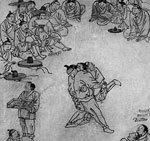Taekwondo 태권도Taekwondo Preschool
Korean martial arts are military practices and methods which have their place in the history of Korea but have been adapted for use by both military and non-military personnel as a method of personal growth or recreation.
Muyesinbo 무예신보
The Muyesinbo (or Muyeshinbo, meaning "new compendium of martial arts") is a Korean martial arts manual published in 1759.
The book is a revision of the older Muyejebo, made during the reign of King Youngjo (1724–1776). It adds twelve disciplines or "skills" of both armed and unarmed fighting by Prince Sado to the original six which were described in the Muyejebo. No copies of the Muyesinbo have survived, but its contents can easily be traced back by comparing the Muyejebo and the later Muyedobotongji.
Prince Sado also originated the term Sib Pal Gi (십팔기, 十八技, “Eighteen Fighting Methods”), shortened from Bonjo Muye Sib Pal Ban (본조무예십팔반, 文章武藝十八般, "18 Martial Arts Classes of the Yi Dynasty", reflecting the Chinese concept of 十八般兵器 "Eighteen Arms of Wushu") to identify this collection of skills.
Historical Background
The earlier manual of 1610, Muyejebo (“Martial Arts Illustrations”) had as its background the Imjin War (1592–1598), which revealed severe shortcomings in the Korean national army causing King Seonjo (1567–1608) to order reforms based on the successful training model of the Chinese General Qi Jiguang (1527–1587).
During the reign of King Yeongjo (1724–1776) the Muyejebo was revised, and supplemented with 12 additional fighting methods by Prince Sado, published in 1759. Prince Sado was the heir-apparent of king Yeongjo, but he suffered from a mental illness which triggered violent outbreaks. After the prince took to randomly killing and raping people in the palace, he was executed by suffocation in 1762, aged 27.
Both the Muyejebo and Muyesinbo formed the basis for the later Muyedobotongji ("Comprehensive Illustrated Manual of Martial Arts") of 1795, which added the execution of six disciplines on horseback, bringing the total number of systems to 24.
The Eighteen Skills
These the eighteen "skills" (技 skill, ability, method) are classified into three categories (thrust, slice, and strike) and reflect strong influence from Chinese martial arts.
The first six skills already present in the Muyejebo can also be found in the Muyesinbo:
- Gonbang 곤봉 (long staff), c.f. Chinese Gun (棍)
- Deungpae 등패 (shield)
- Nangseon 낭선 (thorn spear)
- Jangchang 장창 長槍 (long spear)
- Dangpa 당파 (three-pronged spear)
- Ssangsudo 쌍수도 (two-handed sword)
The remaining twelve skills are original to the Muyesinbo:
- Jukjangchang 죽장창 (long bamboo spear)
- Gichang 기창 (spear with flag)
- Yedo 예도 銳刀 (sharp sword): a single-edged short sword paralleling the Japanese wakizashi.
- Wae geom 왜검 (Japanese sword): the Japanese katana.
- Gyojeon 교전 (sword sparring techniques):
- Woldo 월도 (moon-blade): a polearm with a curving blade paralleling the Chinese guandao.
- Hyeopdo 협도 (spear-blade): a polearm paralleling the Japanese naginata or nagamaki.
- Ssang geom 쌍검 (twin-swords): fighting with two swords; twin-swords were made to be carried in a single sheath.
- Jedok geom 제독검 (admiral sword): techniques introduced by Chinese admiral Li Rusong, who fought on the Korean side in the Imjin War. Li used straight-bladed swords (jikdo) with a single edge for slashing and a double-edged sword (geom) for stabbing. The manual gives 14 basic stances for this discipline.
- Bonguk geom 본국검 (national sword): a method of swordsmanship stressing traditional Korean origin (as opposed to the more recent adoption of the techniques of the "admiral sword").
- Gwonbeop 권법 (unarmed fighting skills): based on the 1567 Jin Xiao Shin Shu or "Manual of New Military Tactic" by General Qi Jiguang (1528-1588). Of the original 32 methods cited by General Qi, about 19 methods are identified in the Muyesinbo, besides another 14 original methods, yielding a total of 33.
- Pyeongon 편곤 (flail): paralleling the Chinese two-section staff
The term Sip Pal Gi in modern Korean martial arts has come to identify three separate but related activities.
Modern Reception
In modern Korean martial arts, Sip Pal Gi has come to be used generically, much like "kung fu" in the west. There are, however, small groups of practitioners who use the term Sip Pal Gi historically, for the attempted reconstruction of 18th-century Korean martial arts based on the historical manuals, much in the same way as martial arts reconstruction in the West.
There are five tenets defined in the International Taekwondo Federation (ITF) and several more in World Taekwondo (WT).
Indomitable Spirit ( 백절불굴 baekjul-boolgool ): "To have indomitable spirit means to have the courage to stand up for what you believe in, no matter what odds you are up against, and to always give 100% effort in whatever you do." View Taekwondo Tenets »
RESOURCES
This article uses material from the Wikipedia article "Muyesinbo", which is released under the Creative Commons Attribution-Share-Alike License 3.0.











